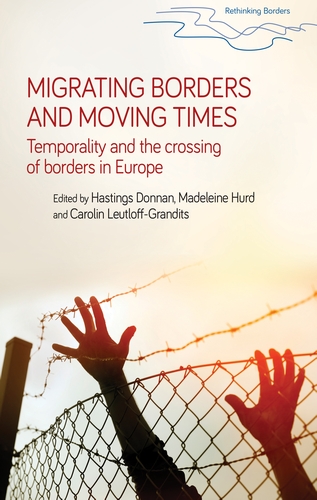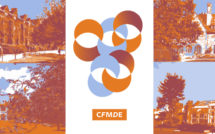
Migrating Borders and Moving Times: Temporality and the Crossing of Borders in Europe edited by Hastings Donnan, Madeleine Hurd and Carolin Leutloff-Grandits
This is part of our special feature on Forced Migration, Displacement, and the Liberal Arts.
 Migrating Borders and Moving Times is an extraordinarily rich collection including many personal testimonies of migrants who experienced dislocation over extended periods of time. While much migration research still focuses on the shift between sending and receiving contexts, this book smashes that mode of thinking and in turn contributes to our understanding of the lingering effects of cross-border mobility as it is experienced, internalized, and refashioned. For analytical purposes we can identify the following themes which run across this volume: the idea of home, micro-regional inequalities, and most important the reconceptualization of time.
Migrating Borders and Moving Times is an extraordinarily rich collection including many personal testimonies of migrants who experienced dislocation over extended periods of time. While much migration research still focuses on the shift between sending and receiving contexts, this book smashes that mode of thinking and in turn contributes to our understanding of the lingering effects of cross-border mobility as it is experienced, internalized, and refashioned. For analytical purposes we can identify the following themes which run across this volume: the idea of home, micro-regional inequalities, and most important the reconceptualization of time.
The editors Hastings Donnan, Madeleine Hurd, and Carolin Leutloff-Grandits state up front that a key premise of this volume considers how people react emotionally in terms of both futures and pasts. In addition, the life-histories presented serve as a corrective to linear and basic conceptions of time. The editors record that the idea of “clock time,” which was introduced in the Enlightenment superseded other types of time, including “personal time.” Yet, as this collection demonstrates, there is much to be gained by re-examining the emotional dimension as it is experienced by both individual and collective migrants and how it may be connected to physical spaces. Arguably that is what makes this volume particularly innovative.
The book focuses on contemporary Europe – with one standalone chapter on Israel. That said, much of it pre-dates the latest political developments. It is far removed from the schisms created by Brexit and the challenges presented by the rise of populist forces across Europe. Only one chapter most closely connects to the present day. It deals with migrants’ deaths in the Mediterranean and recalls the failed dynamic of Europe’s migration policies. This collection nonetheless informs our understanding of political transition from a local and personal perspective, which applies both to the European Union and to its neighboring states. Even if the different chapters present an atypical view of contemporary Europe, they offer an original insight into the everyday lives of millions of Europeans who are forced to work or live abroad, that is most relevant. Another aspect applying to today’s migrants is the way in which minorities are defined. Within Europe, the creation of autochthonous groups is a political act demarcated by particular periods of time, for example, the period when areas were occupied, most notably by Soviet forces. Yet, arguably, within contemporary Europe, the dividing lines of the European Union have created new barriers that in the process have also refashioned our ideas of membership (a point which is most persuasively conveyed here). The authors present several accounts from migrants who have moved across the EU external border, whether migrating for personal or economic reasons between Albania and Greece; between Ukraine and Romania or between Kosovo and parts of Western Europe where they may also constitute minorities in the receiving state. Such flows should be distinguished from those of asylum-seeking populations and forcibly displaced migrants fleeing conflict zones, for example in Bosnia, or from Syria, which also feature in the book.
While the motivations behind their migration journeys differ, the movement of both economic migrants in Central and Southeastern Europe and refugees from Syria nonetheless raise important spatial and temporal questions about how borders are experienced by those seeking to cross them and the process of “re-bordering,” which has been created both by the European project, its expansion, and by conflicts surrounding it. For example, in her chapter on transborder migrants in Ukraine and Romania, Kathryn Cassidy notes that the political hierarchies of the Soviet system where Ukraine was more developed than Romania, have been inverted as a result of Romania’s accession to the European Union. This case illustrates the central premise that it is far too limiting to treat states as having an identity based on a single history; rather such logic imposes a border regime. The lived experience of those seeking to cross those borders tells us something very different and highlights the problems emerging out of such thinking.
The subtitle suggests that this publication is about Europe. That does not do justice to the accounts presented here, which are far more expansive, for example, in showing how ideas of home have been processed in new lands. This is particularly evident in Nataša Gregorič Bon’s chapter, which chronicles divergent migration flows within an Albanian family that moved between several states, including to the US, and Carolin Leutloff-Grandits’ study of migrants who moved between Kosovo and Western Europe. The multidirectional focus of the book merges nostalgia with anticipated futures and is especially novel not least because migration in policy terms is all too often reduced to discreet movements, whether outflows, inflows, or even returns. The truth is that for most migrants, their actual journeys are more complex and their aspirations and ambitions are often far more nuanced.
One further important contribution is the way in which time and space become deeply personal constructs and yet remain rooted to a material basis, for example, in pre-war Bosnia. In Zaira Lofranco’s study of Sarajevo apartment blocks, not only do people recall life before the war but they note how the segregation which followed the ethnic cleansing and outflows has changed the dynamics of everyday life, even within ethnically homogeneous neighborhoods. In the Balkans, Jelena Tošić describes how the borderland is reimagined in Albania and Montenegro, two states that were historically separated but now house similar ethnic populations and, as the author notes, inter-related families. Contrary to the binary logic of ethnic division, she recounts how families switched religions yet retained genealogical links across the two now independent countries. Her story sheds light on the ways in which family may be understood across borders, even in ethnically and religiously heterogeneous populations.
Even though there are chapters focusing on post conflict states including Bosnia, Kosovo and Israel, the interest is not on the politics of transition after war. Rather, the authors are concerned with every day dislocations. The role of time is treated as a structural and overbearing force, for example in the compact between temporary labor migrants and their host state. This tension is persuasively illustrated by Robin Harper and Hani Zubida in their chapter which explores the challenges of temporary labor migrants who live on “borrowed time” in Israel as they await the termination of their contracts. As other authors in this volume similarly argue, time generates social and political borders. What is distinct though is the nature of “migrant time.” The editors suggest we should consider both “rupture time,” where temporary migrants may be forcibly removed from the host state, and “freedom time” which is expressed by new opportunities including greater protection of civil rights. Hence, migrant time should be thought of as a particular bordering process which applies uniquely to the migrant experience.
Several chapters discuss the substantive regional inequalities that have resulted from European integration, or more specifically the enlargement of the EU. In their introductory chapter, the editors suggest that the concept of the “tidemark” is an especially useful metaphor to explain comings and goings and the material traces left by changing borders. Certainly, this metaphor works well for a book that contains sophisticated excursions into the phenomenology of bordering which is presented through ethnographic research. Of particular interest is a chapter on the flâneur. In a beautifully elaborate chapter, Olivier Thomas Kramsch portrays the internal borderland between Northern Germany and the Netherlands with all the mundane detail of urban truck stops between the two states and the raw sentiments of the surrounding area that was destroyed by bombing during the Second World War. In migrants’ daily life, these borders become a montage, an abstract background and reference point. For example, the memory of wartime destruction, which is physically illustrated in ruined building “…speaks to a ‘hidden’ dimension of the border, one defined by a shared experience of massive Allied bombardment and the subsequent imposition of geopolitical manoeuvrings staged from distant state capitals – the Hague and Berlin – in the actual lived space of borderlanders” (page XX). More than collective memory, the author recalls that the actual inter-state border was moved as a result of the bombardment and, hence, the reimagined space is now invisible.
Perhaps the chapter that resonates most closely with the contemporary politics of twenty-first century Europe is the essay by Iosif Lovras and Simon Robins on migrant deaths and unidentified bodies in Lesbos. This chapter illustrates how, in spite of Europe’s attempts to impose an external border, the flow of migrants and above all the tragic loss of life has delegitimized Europe’s pretensions. The authors argue that while the media has focused on shipwrecks, which in turn have prompted European responses including tightened patrols and anti-smuggling initiatives, there is very little discussion on the management of the dead who remain anonymous.
This book is at the cutting edge of the worlds of cultural geography and social anthropology. The contributors do not shy away from theoretical sophistication and the writings are conceptually dense. It is not a quick read. Yet, one of its great merits is the ways in which it advances both theoretical and empirical knowledge. In so doing, the editors have done a great job of pulling together a superb collection of contemporary excursions into little explored European worlds and from the vantage point of migrants themselves.
Reviewed by Brad Blitz, Middlesex University
Migrating Borders and Moving Times: Temporality and the Crossing of Borders in Europe edited by Hastings Donnan, Madeleine Hurd and Carolin Leutloff-Grandits.
Publisher: Manchester University Press
Hardcover / pages 186 / 2017
ISBN: 978152611536
To read more book reviews click here
Published on March 5, 2019.




